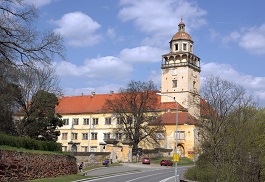
Mor. Krumlov is completing the renovation of the southern wing of the castle, which is set to open in the summer
 |
Krumlov acquired the castle through a successful auction in 2016. Last year, Mucha's Epic temporarily returned to the renovated spaces, and now the first part of extensive repairs is nearing completion. "By the end of June, we would like to have both the repairs and installations completed, so the first interested parties can come for a tour," said Juránek. One section will feature an exhibition from the Institute for the Study of Totalitarian Regimes. It aims to commemorate the coexistence of Moravians, Germans, and Jews in the area. In the lower rooms, centuries-old gravestones that have long been leaning against the cemetery will be displayed. They will now be restored. "They are registered monuments; they will definitely be better off under a roof," Juránek noted. On the floor above, four rooms will focus on the history of the castle, which lost all its interior furnishings during the communist regime. These were either removed or destroyed. "We will manage to get some items back thanks to loans, and we are preparing reproductions of some paintings with the National Heritage Authority, as we have them preserved in photographs," Juránek stated.
In connection with the Epic, the Kampa Museum will also have space for a permanent exhibition. On the third floor, this museum will have one room for temporary exhibitions, which may later serve multifunctional purposes, such as municipal council meetings. "In one room, restorers uncovered wall paintings with plant motifs from the 30s of the 16th century," added Juránek.
Thanks to the renovations, the tower will also be accessible, featuring photographs from its repairs and a 3D model. "We had to create a completely new lantern from new stones; we will also display the old original," Juránek said.
The medieval residence above the town was established as early as the 12th century, and its current form is predominantly Renaissance from the 16th century. After World War II, the castle was nationalized. It first served as headquarters for government offices, then was used by the army, and later various enterprises settled in it. The railway construction company in Brno built a dormitory, classrooms, and apprenticeship workshops here. This situation lasted until 1991, after which it was privately owned for many years.
In the coming years, the northern and western wings are to be renovated, with a study currently being prepared before a project can be undertaken. "We would like to have it as soon as possible, so we can apply for a grant," Juránek said. The city would also like to build an elevator to make the castle accessible to people with disabilities. Discussions with heritage preservationists are currently underway regarding this matter.
The English translation is powered by AI tool. Switch to Czech to view the original text source.
0 comments
add comment
Related articles
1
12.12.2024 | The eastern wing of the castle in Český Krumlov has a new roof costing more than seven million CZK
0
02.04.2024 | In Moravský Krumlov, they are completing the project to renovate the western wing of the chateau
0
20.06.2018 | Moravský Krumlov will repair the south wing of the castle for 119 million
0
15.03.2017 | Moravský Krumlov applied for a grant for the repair of the castle
0
14.10.2016 | Moravský Krumlov commissioned a project for the restoration of the castle
0
27.06.2016 | The castle in Moravský Krumlov will be auctioned on June 29th











